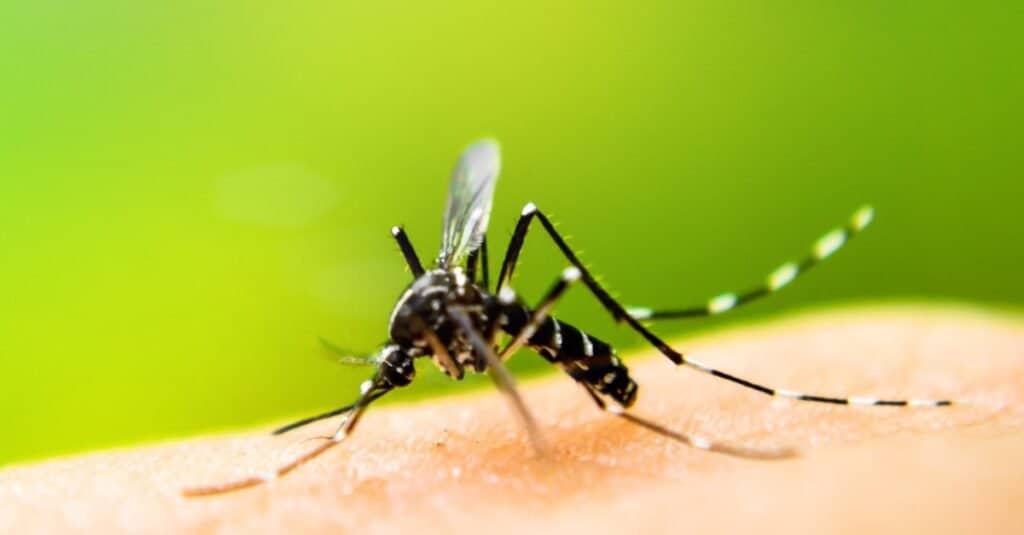Both mosquitoes and mayflies are small, winged insects that can swarm. They live all over the world and prefer warm weather. However, even though they look and behave similarly, these insects couldn’t be more different! Read on to learn the key differences between a mayfly vs mosquito.
Comparing Mayfly vs Mosquito
| Mayfly | Mosquito | |
| Scientific names | Ephemeroptera (Greek origins) | Culicidae (Latin origins) |
| Life cycle | Egg, nymph, sub-imago, and imago | Egg, larva, pupa, and adul |
| Distribution | Worldwide | Worldwide |
| Appearance | Big buggy eyes Slender body Net-like pattern on wings | Small wings extend from middle of thorax About 1 inch in size or less Longer legs than mayfly |
| Human connection | Helpful to the environment | Dangerous due to disease transmission |
The 5 Key Differences Between Mayflies and Mosquitoes

Mosquitoes are just one of millions types of insects.
©Surachai Pung/Shutterstock.com
The key differences between a mayfly and mosquito include their scientific names, life cycle, distribution, appearance, and human connection.
Mayflies have a Greek-derived name, whereas mosquitoes have a Latin-derived name. While mayflies only live for a few hours as adults, annoying adult mosquitoes can live for weeks. Alternatively, a mayfly can take a year to develop, while a mosquito only needs 8 to 10 days to complete its life cycle.
As far as distribution and habitat are concerned, both mosquitoes and mayflies live worldwide. However, these insects have different physical features, making it easy to distinguish them.
Finally, both mayflies and mosquitoes have the potential to help humans and our environment. Keep reading to get more information on the key differences between a mayfly vs mosquito.
Mayfly vs Mosquito: Scientific Names
The scientific name for a mayfly is Ephemeroptera, a Greek word that means short-lived. The name refers to the short amount of time adult mayflies live. Nicknames for the mayfly include drake, fish fly, sandfly, dayfly, and shadfly.
The scientific name for mosquito is Culicidae, a Latin word that means gnat. The name makes sense considering mosquitoes are small and annoying, just like gnats!
Mayfly vs Mosquito: Life Cycle

Mayflies only live for a few hours as adults.
©Dimijana/Shutterstock.com
An adult mayfly only lives for a few hours. They might live for over a day in particular situations, but that’s rare. Instead of spending their lives flying around, most of the mayfly’s life is spent underwater.
There are four stages to the mayflies’ life cycle; egg, nymph, sub-imago, and imago. They can spend years in the juvenile stage.
Once they molt and enter the sub-imago stage, mayflies become extra vulnerable to predators. In this stage of their life, they live out of the water but don’t have the ability to fly yet. The entire transformation from egg to adult can take up to a year or more to complete.
Mosquitoes also have four stages in their life cycle; egg, larva, pupa, and adult. When the female mosquito lays eggs, they come out one at a time. The eggs are sticky and stay together to form a raft of 100 to 300 eggs.
The raft of mosquito eggs can float on the water until they enter the larva stage. The mosquito life cycle is much faster and only takes about 8 to 10 days to complete.
After reaching adulthood, mosquitoes usually live for around 2 to 3 weeks. Their lifespan depends on the surrounding conditions and available food sources.
Mayfly vs Mosquito: Distribution and Habitat
Mayflies live all over the world. You can find mayflies in South America, Asia, Africa, Eurasia, and North America. There’s an abundance of mayflies throughout Central America too!
Mayflies thrive in aquatic environments. The first few months of their lives are spent underwater. They require streams, rivers, lakes, and other bodies of water to live.
Mosquitoes also live all over the world, but they have a much wider variety of habitats. Even though they enjoy warm tropical environments, they’re also known to survive colder weather too.
There are plenty of mosquitoes living in Alaska during the warmer seasons. Large groups of mosquitoes will take shelter and hollow tree trunks or buildings when it gets too cold.
Mayfly vs Mosquito: Appearance

Mosquitoes have a mouh whereas adult mayflies do not.
©iStock.com/auimeesri
Mayflies are famous for having big buggy eyes. Their slender body attaches to the thorax, similar to how a butterfly’s body connects. This gives the mayflies an exaggerated appearance for their eyes. Mayflies also have clear triangular wings that can be quite large. You’ll find vertical and horizontal veins throughout the wings that create a fun pattern. Their wings are much larger at the front of their body, with their hind wings almost impossible to see.
If you’re looking at a bug and you can’t tell if it’s a mayfly or a mosquito, notice the size of the wings. Mayfly wings are always going to be more pronounced and longer than mosquito wings and are also going to slant upward. The mosquito’s wings extend from the middle of their thorax.
Adult mosquitoes also have a slender bodies, and their legs can appear longer than the mayflies. A lot of mosquitoes are less than an inch long. You’re more likely to hear a mosquito before you see it. Mosquitoes are infamous for buzzing around their victims before taking a bite.
One thing a mosquito has that a mayfly doesn’t have is a mouth. Mayflies don’t need a mouth because the adults die within a day. Mosquitoes, on the other hand, use their mouths to create some of the itchiest bites possible. Fun fact; only female mosquitoes bite.
Mayfly vs Mosquito: Human Connection
Anglers all over the world understand just how important mayflies are. Mayflies provide a priceless service to humans and their surrounding ecosystems. Worldwide, human cultures use mayflies as a source of food, in scientific experiments, and to study anti-tumor molecules. In the wild, mayfly nymphs help prevent excess buildup of aquatic algae. The short-lived mayflies are also an abundant food source for all sorts of predators.
However, unlike mayflies, mosquitoes also present a major threat to humans. Along with being annoying, mosquitoes are carriers for some of the most deadly illnesses and diseases. They’re one of the biggest enemies of the global fight against infectious disease. Scientists are looking for ways to sterilize mosquitoes to control their populations.
On a more positive note, plenty of predators help control the mosquito population. Bats, birds, fish, frogs, and turtles all love feeding on mosquitoes.
Up Next
- No See Ums vs Mosquitoes: Key Differences Explained
- What Do Mosquitoes Eat?
- Where Do Mosquitoes Go In The Winter?
- Mosquito Predators: What Eats Mosquitoes?
The photo featured at the top of this post is © iStock.com/nechaev-kon
Thank you for reading! Have some feedback for us? Contact the AZ Animals editorial team.






